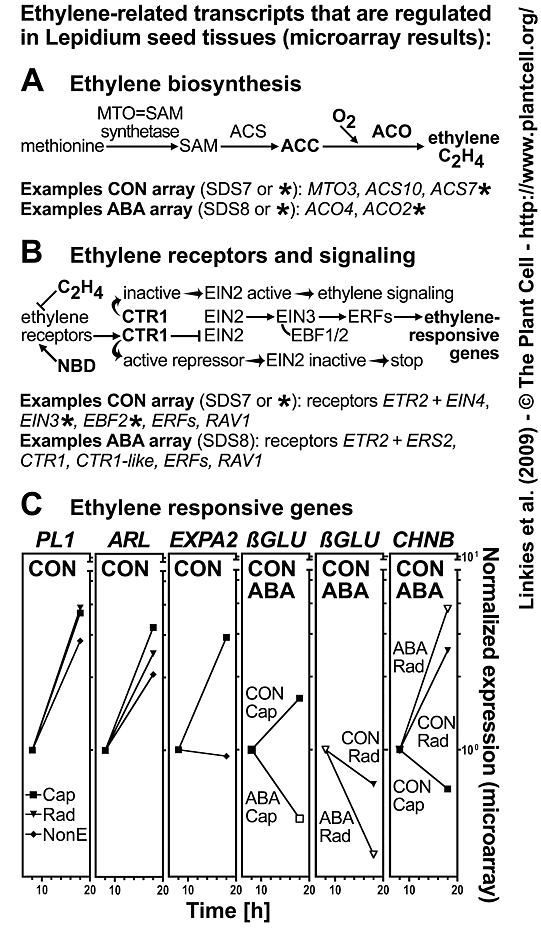The Plant Cell 21: 3803-3822 (2009)
Ethylene interacts with abscisic acid to regulate endosperm rupture during germination: a comparative approach using Lepidium sativum and Arabidopsis thaliana [W][OA]
Warwick Horticulture Research International (HRI), Warwick University, Wellesbourne, Warwick CV35 9EF, United Kingdom (Ka.M., C.S.C.C., J.R.L., W.E.F.-S.)
Palacky University and Institute of Experimental Botany Academy of Sciences of the Czech Republic, Laboratory of Growth Regulators, CZ-78371 Olomouc, Czech Republic (V.T., M.S.)
Université Pierre et Marie Curie-Paris 6, Germination et Dormance des Semences, UR5, Site d'Ivry, F-75005 Paris, France (F.C.)
Received July 23, 2009; Returned for revision October 12, 2009; Accepted November 17, 2009; Published December 18, 2009
www.plantcell.org/cgi/doi/10.1105/tpc.109.070201
 |
Figure 4. Ethylene-related regulated transcripts in Lepidium sativum FR1 seed tissues. The regulated transcript data sets of the Lepidium seed arrays (see Supplemental Data Sets 5 [CON, 1350 transcripts] and 6 [ABA, 3530 transcripts] online) were analyzed in two ways. First, TAGGIT analysis (see Supplemental Figure 1 online) was performed, and transcripts of the functional category “ethylene” were indentified in this analysis. Second, comparison to Arabidopsis transcriptome data sets known to be regulated in seedlings by ethylene and/or ABA (Nemhauser et al., 2006) provided transcript subsets that are regulated in seeds as well as by ethylene and/or ABA in seedlings (see Supplemental Data Sets 7 [CON array] and 8 [ABA array] online; SDS7 and SDS8 in Figure 4). These ethylene-related transcripts were considered further in (A) to (C). Examples of these ethylene-related transcripts shown in (A) and (B) are from the CON array and ABA array, as indicated. Those that are not marked are regulated in seedlings by ethylene and/or ABA and therefore appear on the subset lists SDS7 and SDS8, whereas those that are marked with an asterisk are not and therefore do not appear in subset lists (see Venn diagrams in SDS7 and SDS8). (A) Key steps in ethylene biosynthesis include the oxygen-requiring conversion of ACC (1-aminocyclopropane-1-carboxylic acid) to ethylene by ACO (ACC oxidase). (B) Key steps in ethylene signaling include ethylene binding to the receptors, which can be blocked by the ethylene action inhibitor NBD. In the absence of ethylene or with NBD bound to the ethylene receptors activating CTR1, a negative regulator of the downstream signaling pathway and the ethylene responses are blocked. Upon ethylene binding, the receptors and consequently CTR1 are inactive and the downstream signaling pathway factors (EIN2, EIN3, and ERFs) become active and mediate the expression of genes that facilitate the ethylene responses. (C) Normalized expression values for transcripts of selected ethylene responsive genes that are regulated in seeds (CON and ABA arrays; see Supplemental Data Sets 3 and 4 online, respectively). ACS, ACC synthase; ERE, ethylene-responsive element. |
Synopsis: Tissue weakening of the endosperm is required to allow radicle protrusion during seed germination. Cross-species work including tissue-specific transcriptome analysis and biomechanical measurement of endosperm weakening provided a new mechanistic model that explains how ethylene promotes seed germination and counteracts the inhibition of endosperm cap weakening by abscisic acid.
| Article in PDF format (1.8 MB) Supplemental data file (1.8 MB) Abstract of Plant Cell 2009 |
|
|
|
The Seed Biology Place |
Webdesign Gerhard Leubner 2000 |